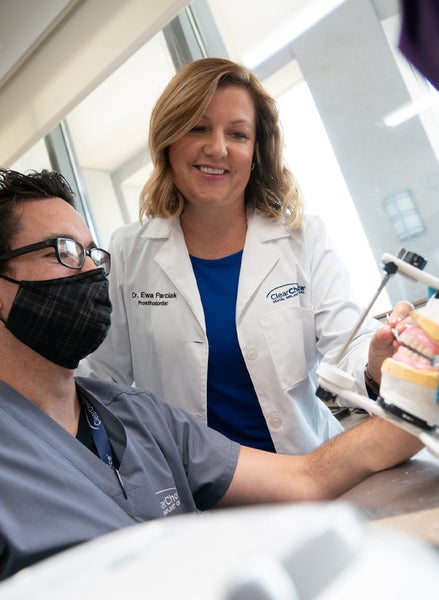Last updated 06.09.2025
What is a dental flipper? Flipper tooth vs. implant tooth
Dental implants and flippers replace missing teeth. Flippers are temporary, while implants can last a lifetime.

During the tooth replacement process, you often need a temporary tooth while you wait for the jaw to heal or for your dentist to fabricate a more permanent solution. This temporary tooth is called a flipper tooth, which helps fill the gap while you wait for a more permanent solution.
But what is a dental flipper? Is it different from a dental implant or is it one of the steps of dental implant treatment? Why should you eventually transition from a dental flipper to a more permanent solution? Read on to discover the benefits of dental implant treatment, and choose the best tooth replacement solution for your needs and quality of life.

What is a dental flipper?
The official dental term is a “temporary removable partial denture prosthesis” that fills the space of a missing tooth. The flipper is removable by the patient. It is a lightweight acrylic resin prosthesis that adapts around the adjacent teeth, and although it fits snugly, the experienced flipper wearer can “flip it out of their mouth” with a flick of the tongue or finger, hence the name given to it by the flipper wearing public. The flipper is a very common removable prosthesis, but it is intended to be an esthetic placeholder solution until a dental implant restoration or dental bridge can be placed. They typically last for a few months to a year, depending on oral hygiene and wear and tear.

Pros and cons of dental flippers
Dental flippers are a popular choice among patients for several reasons, but they also come with their own set of challenges. Let's break down the pros and cons of dental flippers:
Pro: Cost-effective
One of the biggest advantages of dental flippers is their affordability. Compared to permanent solutions like implants or bridges, dental flippers have a much lower upfront cost. This can make them an attractive choice for individuals on a budget or those looking for a temporary solution.
Pro: Quick procedure
The dental flipper process is relatively quick and straightforward. Once your dentist has taken impressions of your teeth, your flipper tooth can usually be created within a few days.
Pro: Temporarily stabilizes the position of the surrounding teeth
A dental flipper can help prevent surrounding teeth from shifting into the space left by a missing tooth. This temporary stabilization is crucial for maintaining proper alignment, until a more permanent replacement option can be arranged.

Con: Less durability
While dental flippers are convenient, they are not as durable as permanent solutions. They are made from lightweight acrylic resin, which is susceptible to breaking or cracking the longer it is worn. Chewing or biting with the flipper can actually shorten its life-span. You need to clean your flipper carefully, as it is fragile and can break easily. Because of this, dental flippers aren't ideal for long-term use.
Con: Discomfort
Some patients may experience initial discomfort when wearing a dental flipper, especially as they adjust to wearing it. Dental flippers might also feel bulky in the mouth, which can be bothersome for some patients.
Con: Lack of jawbone stimulation
Unlike dental implants, dental flippers do not stimulate the jawbone. Without stimulation, the jawbone in the area of the missing tooth can deteriorate over time, impacting your oral health.
Dental Implants: Tooth replacement option
If you're looking for a permanent dental replacement option instead of temporary fixes, dental implant treatment may be the right fit for you. Implants offer unmatched durability, functionality, and aesthetics, making them a favorite among patients, and dental professionals alike, for replacing missing teeth.
A dental implant restoration consists of a titanium post that serves as an artificial root, a connector (dental implant abutment), and a custom-made crown that resembles your natural teeth. The implant fuses with the jawbone through a process called osseointegration, providing stability and lessening the risk of bone loss.
While dental implants are more expensive and involve a longer procedure compared to dental flippers, their long-term benefits often outweigh these factors.

Flipper tooth vs. dental implant
Here are some key factors to evaluate:
Cost
Dental flippers are significantly cheaper than implants upfront, making them a budget-friendly option. However, implants can be considered a better long-term investment, because they enable complete chewing function and are not removable.
Aesthetics
Both dental flippers and implants are designed to look natural, but implants generally offer a more seamless and realistic appearance. Implant crowns are customized to match the exact color, shape, and size of your existing teeth, while flippers may lack that level of precision.
Functionality
Dental implants function like natural teeth, allowing you to bite, chew, and speak with confidence. On the other hand, flipper teeth are less stable and may shift during eating or speaking, which can be inconvenient.
Durability
Dental implant restorations can last a lifetime with proper care and maintenance. Meanwhile, flippers are designed as a temporary solution, and will need to be replaced over time due to wear and tear.
Stability and comfort
Dental implants are firmly secured in your jawbone, offering superior stability and comfort. Flippers, while custom-fit, may feel less secure, and may cause minor discomfort with prolonged use.
Protection from bone loss
Unlike the flipper, dental implants are placed within the jawbone which stimulates the bone when you chew on the implant crown. Flippers do not provide this benefit, which could lead to bone loss over time.
Versatility
While flippers are limited to temporary use for minor tooth loss, dental implants can be used to replace single teeth, multiple teeth, or an entire arch. This makes dental implant restorations a more versatile solution for your unique situation.
Consult with a ClearChoice doctor to learn more about tooth replacement options
If you are unsure about which tooth replacement option is best for you, consider consulting with a ClearChoice doctor. ClearChoice specializes in providing comprehensive care and personalized treatment plans tailored to your specific needs. Our team of experienced specialists will guide you through the process and help you explore all available options.
Dental flipper FAQs
How long can I wear a dental flipper?
Because dental flippers are designed for temporary use, their longevity depends on how well they're maintained. Flippers increase the risk of dental decay on the adjacent teeth where the flipper rests. Plaque builds up on the flipper and the teeth. Hygiene must be meticulous in this area. On average, dental flippers can last several months to a year with proper care. However, they should be replaced or upgraded to a permanent solution as recommended by your dentist.
Can I eat with a flipper tooth?
Yes, you can leave your flipper in your mouth when you eat, but you should avoid overly hard, sticky, or chewy foods that could damage the flipper. Soft, easy-to-chew foods help reduce unnecessary stress on the flipper.
Why does my flipper tooth hurt?
There are several possible reasons you might have discomfort with a dental flipper. Possible causes include improper fit, irritation of the gum tissue, or underlying dental issues in the adjacent teeth. If your flipper tooth causes persistent pain, consult with your dentist for adjustments or further evaluation.
Can I sleep with my dental flipper in my mouth?
We don't advise sleeping with a dental flipper in your mouth. Removing your flipper before bed gives your gums a chance to rest. It also lessens the chance of irritation to your gums, bacterial buildup on the flipper and adjacent teeth, or damage to the flipper if you grind your teeth at night.
How do I clean my flipper?
You must remove the flipper to clean it. Use a soft bristle brush and scrub it inside and out. Especially pay attention to the areas that touch your natural teeth. Plaque builds up in those areas. At night, keeping it in water keeps the acrylic from drying out. Believe it or not, your dog is waiting for you to put your flipper in a place where it can be discovered and become a chew toy. Even putting it in a denture container on your night stand, will not keep your dog at bay.
Schedule free consultation>



